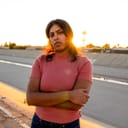Stay in the Loop
BSR publishes on a weekly schedule, with an email newsletter every Wednesday and Thursday morning. There’s no paywall, and subscribing is always free.
Picturing Philly’s educational and social landscape
Da Vinci Art Alliance presents Reimagining Monoliths

Da Vinci Art Alliance’s 2022 Kathryn Pannepacker fellow Michael Smaczylo debuts his new exhibition Reimagining Monoliths: a visual representation of Philadelphia’s aging schools and the diverse neighborhoods in which they reside. The exhibition includes a collection of silk-screened posters that explore the educational and social landscapes of Philadelphia.
Building on education
Born and raised in Philadelphia, Smaczylo is an educator invested in improving the city’s schools. When creating the body of work for Reimagining Monoliths, Smaczylo conducted arts-based research on the architectural history of some of Philadelphia’s public schools built during the progressive era of education. Constructed between 1907 and 1935, these buildings were “designed in traditional western architectural styles, representing a massive investment in public education and a gesture of hope for the future. However, a century later, these decaying and towering structures along with the aesthetics they embody now represent the government’s disinvestment in urban education and in the communities they are meant to serve.”
Focusing on specific schools and locales within Philadelphia, Smaczylo broadened his research to explore everything from demographics and property values to school-funding structures and the ongoing battle for stewardship of Philadelphia’s public schools. Reimagining Monoliths is made up of photography, digital collage, illustration, and printmaking. Smaczylo developed large-scale silk-screened poster prints documenting 10 specific schools and their surrounding communities. These multilayered prints were designed to serve as visual examinations of the impacts caused by historic urban infrastructure, administrative oversight, and inequality in public school funding.
Smaczylo is also an illustrator and printmaker with a bachelor's degree in illustration from the University of the Arts and a master’s in art education from Temple University. Currently serving as the art teacher at Kensington Health Sciences Academy, Smaczylo focuses on urban education, educational activism and reform, and education for social liberation. At the heart of his teaching philosophy, Smaczylo believes that “all students' lives, stories, and art have value,” he says. “Through art, students connect more deeply to themselves, their peers, their inspirations, and their communities. This connection allows them to craft and control their own narratives, personal stories, and expressions through art. It is through these narratives, themes, points of view, and experiences that students achieve the agency to make true social change in the world, reshaping the future for themselves.”
Smaczylo believes a visual arts curriculum should be focused on developing creativity, honing students' own personal interests, and generating art that is deeply personal. His goal as an arts educator is to help students refine their skills in order to more efficiently express their own personal artistic viewpoints.
What, When, Where
Reimagining Monoliths. By Mike Smaczylo. Through October 12, 2022, in Gallery 1 at the Da Vinci Art Alliance, 704 Catharine Street, Philadelphia. Also available as a video walkthrough. (267) 388-2835 or davinciartalliance.org.
Accessibility
DVAA is in a historic two-story row home with four steep steps at the entrance of the building and a flight of stairs to the second floor. This building is not wheelchair-accessible; however, DVAA will attempt to accommodate to the fullest extent possible.
For information, or to notify DVAA of any needs prior to your visit, contact [email protected].
Sign up for our newsletter
All of the week's new articles, all in one place. Sign up for the free weekly BSR newsletters, and don't miss a conversation.

 Christina Anthony
Christina Anthony